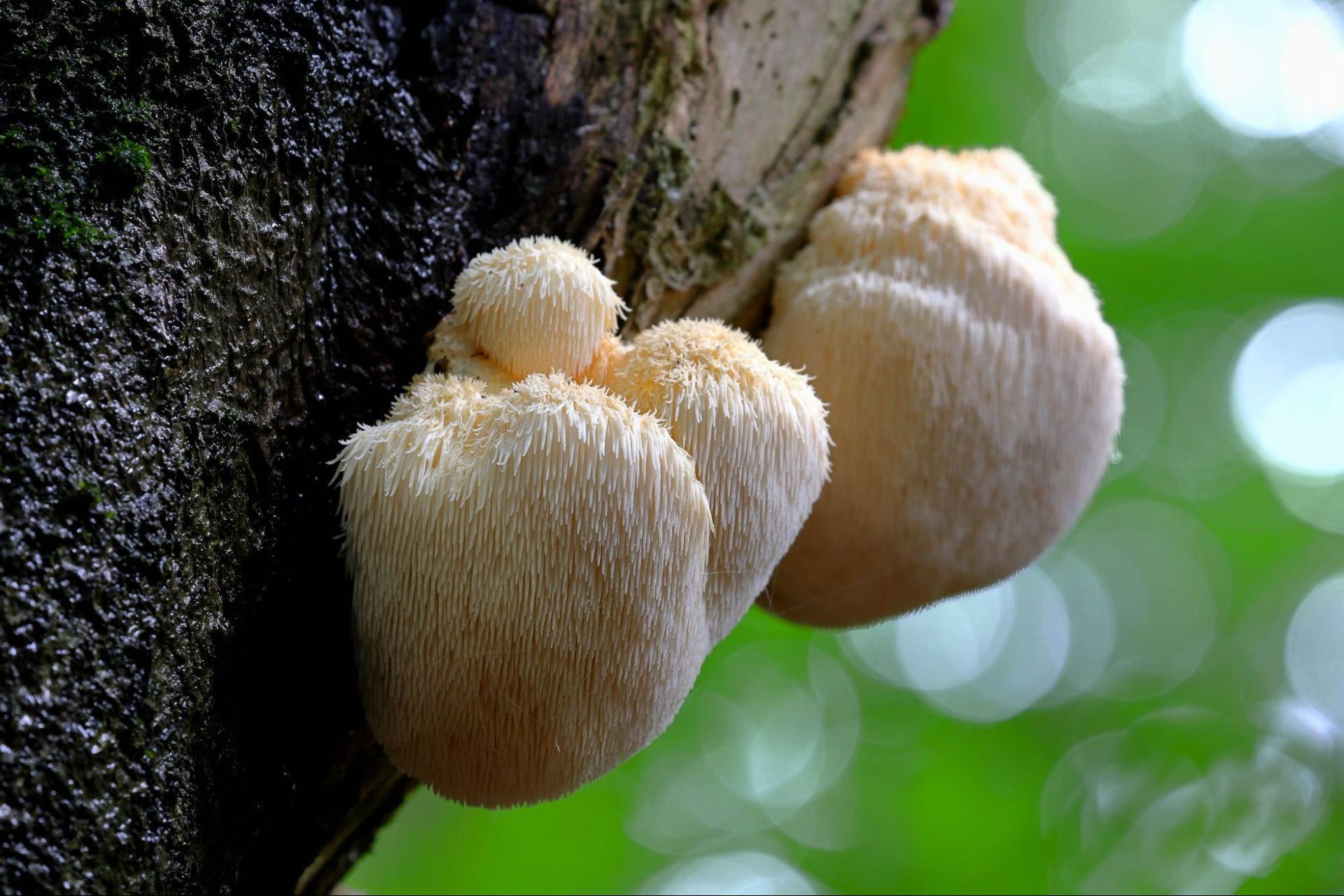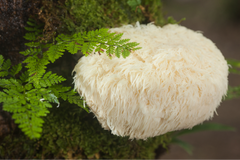Lion’s Mane Mushroom Benefits*

Often referred to as “The Smart Mushroom,” Lion’s Mane is one of the most well-known beneficial mushroom species world-wide. With important benefits for brain health, like supporting memory, cognition, and mental clarity, Lion’s Mane is a popular supplement choice among those seeking focus in today’s often hectic and distracting world.*
Lion’s Mane has a long history of use cross-culturally throughout centuries wherever it’s found in nature. Use of Lion’s Mane was once only surmised to benefit health, based on anecdotal evidence and observation. But research and modern science has since demonstrated that it is, in fact, a health-supporting fungi with a broad range of benefits to humans.*
Lion’s Mane appearance and scientific classification
What does Lion’s Mane look like?
Lion’s Mane is striking in appearance, with cascading tendrils extending from snow-white fruit bodies - resembling the mane of a lion! Lion’s Mane fruit bodies can actually vary greatly in size, with some specimens growing to more than 30 inches in diameter, while others form only a single “pom pom”. Many environmental factors, including temperature, precipitation, and the health of the substrate host upon which the Lion’s Mane is growing, can all influence the overall size and longevity of the fruit body.



Lion’s Mane in Latin: A Lion, a Hedgehog, or a Mushroom?
The Latin name, or Latin binomial, for Lion’s Mane is Hericium erinaceus. When translated, it refers to the distinctive, bushy “mane” shape of the fungal organism. Hericium means “hedgehog.” While not quite as conspicuous as the mane on a Lion, a hedgehog has its own distinctive fluffy, sometimes spikey, dense fur that perhaps more closely resembles a smaller specimen of the mushroom species that bears its name.
In addition to Hericium meaning “hedgehog”, erinaceus is actually the Latin name of a hedgehog genus found throughout Europe, the Middle East, and into Asia. So, essentially, the Latin name of this incredible mushroom species translates to…Hedgehog hedgehog!
Lion’s Mane: A gourmet gift from nature
Cooking with Lion’s Mane
The fruit bodies of Lion’s Mane are considered a delicacy and enjoyed for a unique flavor that is often compared to lobster or other seafood. A popular gourmet mushroom, it has a dense, slightly spongy texture that is ideal for slicing up, marinating, and sauteeing in the skillet! Many mushroom enthusiasts (including our resident expert, Paul Stamets!) have described Lion’s Mane as being among their favorite edible species.
Like all gourmet or edible mushrooms, the fruit bodies of Lion’s Mane should only be eaten when very fresh. It’s important to harvest with care to avoid bruising, which will cause the fruit body to begin decomposing at a faster rate. Signs that Lion’s Mane fruit bodies are inedible include significant discoloration and an unpleasant odor.


Beyond supporting the health of humans when harnessed in the form of a supplement, Lion’s Mane is a well-known gourmet mushroom, and enjoyed by many for its delicious flavor that is most often compared to lobster.*
Native habitat of Lion’s Mane
Lion’s Mane is found in temperate climates in Asia, Europe, and North America. As a saprophytic fungus, Lion’s Mane grows on (and digests) wood on both living and dead trees. Lion’s Mane prefers hardwood trees like Maple, Oak, and Beech. Through the work of its hidden mycelial network, Lion’s Mane recycles nutrients from fallen trees back into the soil. This ability to redistribute nutrients to other forest organisms makes it an important member of its native ecosystems.

Mature Lion's Mane fruit body in a temperate climate forest on a hardwood tree.
Though Lion’s Mane is found throughout the northern hemisphere, it is rare in many regions. In fact, Lion’s Mane is classified as regionally at-risk and endangered in several European countries, where it is illegal to harvest from the wild. This includes the UK, where it is one of the few fungal species given the highest available level of legal protection.
Lion’s Mane grows in the United States, along with at least three other Hericium species. While they all produce fleshy, white fruit bodies, not all of these species have the distinct “spikey” hedgehog appearance or the mane-like “tendrils” found on Hericium erinaceus.
 Small Lion’s Mane fruit body
Small Lion’s Mane fruit body
Life cycle of Lion’s Mane
Lion’s Mane typically fruits in the summer or fall, when its distinctive fruit bodies emerge from myceliated wood. It often grows on decaying stumps and logs, but fruit bodies may also be seen growing out of wounds in living trees.
As the reproductive part of the organism, the fruit bodies of Lion’s Mane are relatively short-lived, lasting for only days or weeks. In comparison, and as is the case with other mushroom species, mycelium is the primary and most active part of the Lion’s Mane organism, with a lifespan of months or years. Fruit bodies release spores that can inoculate new host trees or logs, where mycelium then grows, starting the life cycle anew.
Once established, it is likely that the mycelium of an individual Lion’s Mane organism can live for many years. While there has been little scientific research into the lifespan of Lion’s Mane, it’s believed that an organism may live for as long as it can extract nutrients from its host, sprouting fruit bodies that come and go when the right conditions are met, but the mycelium itself can remain vibrant and active for potentially years or even decades!
Traditional use of Lion’s Mane
Lion’s Mane has been used for centuries and is celebrated by many cultures, particularly in Asia. Its Japanese name Yamabushitake roughly translates to “Mountain-Priest Mushroom” because Lion’s Mane fruit bodies are said to resemble a garment worn by the Shungendō sect of Buddhist monks. In China, Lion’s Mane is known as Hóu Tóu Gū (Monkey’s Head mushroom) and Shishigashira (Lion’s Head). It has been both enjoyed as a gourmet addition to meals and for its numerous health benefits.*
Benefits of Lion’s Mane*
What modern science says about Lion’s Mane
Lion’s Mane support for brain health*
Lion’s Mane earned the nickname “The Smart Mushroom” because of its benefits to brain health. When used in the form of a supplement, Lion’s Mane has been shown to support memory, cognition, and mental clarity, becoming a favorite of anyone seeking to keep their mental edge.*

Lion’s Mane support for mood, digestion & immune health*
But the health-supporting benefits of Lion’s Mane go beyond the brain! Lion’s Mane has also been shown to promote a balanced mood, digestive wellness, and an engaged yet balanced immune response. Additionally, research suggests that Lion’s Mane may support sleep quality, blood sugar levels already within the normal range, and balanced energy levels.*
 Paul Stamets holding Lion's Mane mushroom mycelium capsules.
Paul Stamets holding Lion's Mane mushroom mycelium capsules.
Lion’s Mane support for whole-body wellness*
Because Lion’s Mane supports the health of both brain and body, it’s a great functional food to add to any supplement routine, or a delicious culinary delight that can be added to a healthy diet.*
Research on Lion’s Mane mycelium
Both Lion’s Mane fruit bodies and mycelium have been shown to support a balanced immune response, and both are used to make supplements for human consumption. However, recent research indicates that the mycelium from Lion’s Mane includes constituents not found in fruit bodies.*
Erinacine A, one of the most well-studied neuroactive fungal compounds in scientific literature, is known to support nerve growth factor (NGF), which promotes nervous system and neurological health. Erinacine A was first discovered in culture samples of Lion’s Mane mycelium. To date, erinacine A has not been conclusively found in the fruiting body of Lion’s Mane.*
 Culture plate of Lion's Mane mushroom mycelium at the Fungi Perfecti lab.
Culture plate of Lion's Mane mushroom mycelium at the Fungi Perfecti lab.
A recent analysis conducted by the Research and Development team at Fungi Perfecti of both Lion’s Mane fruiting bodies and mycelium reinforced those findings. While no erinacine A was detected in the fruiting body tissue sample, it was detected in the samples of mycelium!
Additionally, in their study they compared samples of raw organic brown rice to samples of organic brown rice that had been colonized by Lion’s Mane mycelium. Once colonized - or fermented - the brown rice-mycelium biomass showcases a vastly different chemical complexity compared to the raw brown rice on its own.


The two graphs above show the results of High-Pressure Liquid Chromatography (HPLC) analysis on uninoculated brown rice (in blue), and brown rice colonized by Lion's Mane (Hericium erinaceus) mycelium (in red). Brown rice colonized by Lion's Mane demonstrates a significant increase in compound activity not present in brown rice alone, including the presence of Erinacine A, a compound known for cognitive support.*
In research by multiple authorities, it has been shown that Lion's Mane and the fermented rice substrate may offer a broader range of beneficial compounds than fruit bodies alone.*
Within the complex biochemistry of the fermented brown rice biomass, there exist thousands of minor and trace compounds that may have important bioactivities and support synergy within the matrix. More studies will be needed to extract out the significance of these exciting discoveries!*
*These statements have not been evaluated by the Food and Drug Administration. This product is not intended to diagnose, treat, cure, or prevent any disease.
